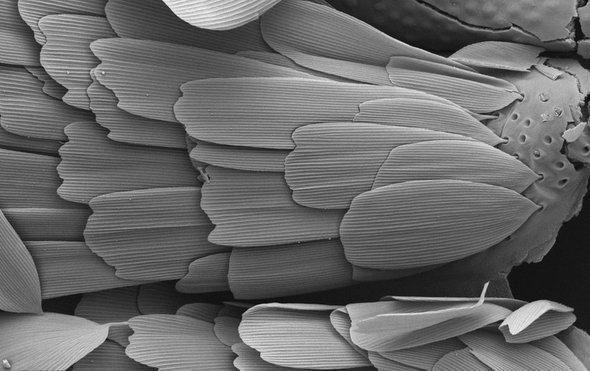(单词翻译:单击)
听力文本
This is Scientific American — 60-Second Science. I'm Christopher Intagliata.
To learn about the plant life of long ago, scientists dig through layers of the Earth, looking for fossil clues. Like bits of fossilized pollen, or spores.
"And that's where I come in." Timo van Eldijk (EL-dike) is an evolutionary biologist at Utrecht University. He was called into action when his pollen-hunting pals noticed something altogether different, in a sample of sediment more than 200 million years old dug from a thousand feet below the surface of Germany: bits of insect.
"I took a human nose hair, because that's the way you isolate these things. You have a needle tipped with a human nose hair, apparently it has just the right springiness for the isolation."
Whose nose hair? "I don't actually know. There was a joke going around it was one of the professors, but we don't actually know."
So, using someone's nose hair, van Eldijk picked through the sludgy sediment, and isolated the tiny scales of moth wings—the stuff that looks like dust, if you touch a butterfly or moth.
His team scanned those scales with an electron microscope, and made a crucial discovery: some of the scales were hollow. The fossil record shows that: "First came the proboscis and then came the hollow scales. We can then infer, if we find the hollow scales, there must already have been a proboscis."

So what's the big deal? The finding means that these samples predate existing evidence for the first butterfly tongues by 70 million years. Which in turn implies that an early version of the proboscis, which in modern insects can pry into a flower's nooks and crannies for nectar, appears to have evolved before the appearance of flowers—not as a response. The study is in the journal Science Advances.
The early proboscis might have been used to pluck drops of liquid from the tips of ancient forms of today's pine tree cones. And it's clear that these sucking tongues underwent a lot of remodeling after the emergence of flowers, as flowers and moths co-evolved.
But van Eldijk is hoping insect scales might become more widely used as a tool to investigate the ancient world. "We're hoping that people will start recognizing them in other places. You can even imagine sort of a scenario in which we can reconstruct past ecosystems based on the scales that you find in a core, much similar to the way we do with pollen now."
All scientists have to do is follow their noses—or at least their nose hairs.
Thanks for listening for Scientific American — 60-Second Science. I'm Christopher Intagliata.
参考译文
这里是科学美国人——60秒科学。我是克里斯托弗·因塔利亚塔。
为了研究很久以前的植物生命,科学家们挖穿了地层,寻找化石线索。比如少量的化石花粉或孢子碎片。
“这就是我的着手点。”乌得勒支大学的进化生物学家蒂莫·范艾尔杰克说到。他展开研究,是因为他那个寻找花粉的朋友,在从德国地下1000英尺处挖出的2亿多年前的沉积样本中,发现了完全不同的东西:少量昆虫。
“我拿了一根人类的的鼻毛,因为要用它隔开这些东西。拿着前端有一根针的人类鼻毛,显然其弹性正合适隔开东西。”
那这是谁的鼻毛呢?“其实我也不知道。我们开玩笑说这是其中一名教授的鼻毛,不过其实我们并不知道是谁的。”
所以,范艾尔杰克用某个人的鼻毛在布满淤泥的沉积物里仔细搜寻,而且将蛾子翅膀的小鳞片挑了出来,这种小鳞片就是你在触摸蝴蝶或蛾子的翅膀时,看到的很像尘土的东西。
他的团队用电子显微镜扫描了这些鳞片后有了重大发现:有些鳞片是空心的。化石记录显示:“蛾类或蝴蝶的喙先于空心鳞片出现。我们可以推测,如果我们发现了空心鳞片,那蛾子或蝴蝶就一定有喙了。”
这有什么重要的?这一发现意味着,这些样本比首批蝴蝶舌头的现有证据早了7000万年。这反过来暗示,现代昆虫用来刺探花朵各处以寻找花蜜的喙,其早期形式可能在花出现之前就已经进化了,而不是因为花朵的出现才进化的。这项研究结果发表在《科学进展》期刊上。
早期的喙可能被用来吸取古代版松果尖端的液滴。很明显,这些吸吮舌头在花出现后经历了大量的重塑,因为花和蛾子在共同进化。
但是范艾尔杰克希望,昆虫鳞片能被当作研究古代世界的工具而更广泛的使用。“我们希望人们能开始在其他地方认识它们。你甚至可以想象这样一个情景:我们能根据果核里发现的鳞片重塑过去的生态系统,这与我们目前利用花粉的方式非常类似。”
所有科学家必须要做的是,跟随他们的鼻子——或至少是他们的鼻毛来进行研究。
谢谢大家收听科学美国人——60秒科学。我是克里斯托弗·因塔利亚塔。
译文为可可英语翻译,未经授权请勿转载!
重点讲解
重点讲解:
1. look for 找;寻;
例句:They look for foods that are low in calories.
他们要找低卡路里的食物。
2. come in (在某件事中)起作用,发挥作用;
例句:Finally, he could do no more, which is where Jacques came in.
最后,他再也无能为力了,这也正是雅克发挥作用的时候。
3. go around (消息或笑话)流传,传播;
例句:There's a nasty sort of rumour going around about it.
关于这件事正有一则恶意的谣言在流传。
4. in turn 继而;转而;反过来;
例句:All theories originate from practice and in turn serve practice.
任何理论都来源于实践,反过来为实践服务。


